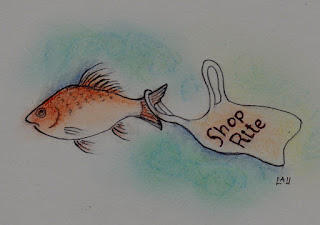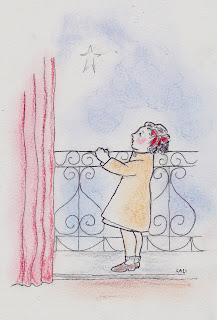Back in the mists of our
early marriage, my husband showed me how to check the air pressure in the car tires.
But those were the halcyon days of full-service gas stations, when the
attendant always asked “check your tires, ma’am?” I would answer yes, and he
would crawl around the car doing whatever was needed while I sat drumming my
fingers on the steering wheel and looking off into space.
Now, a half century later,
the chickens of my cavalier attitude towards tire maintenance have come to
roost. Twice in the last six months, while I was far from home, the tire warning
light gave me a fright by coming on.
The first time was during an
episode of “wintry mix,” when the sky was simultaneously spewing rain, snow,
and those annoying Styrofoam-like ice pellets. I was wearing a down vest instead
of a parka and shoes instead of boots—I had expected to stay in the car, after
all—and when I pulled into a filling station I had to tromp through a mountain of
gritty snow that the plow had piled in front of the air pump.
I connected the air pump hose
into my tire, got some quarters, waded into the snow bank, fed the machine, returned
to the tire—and nothing happened. I offered the machine more quarters, hoping
that my generosity would persuade it to disgorge some air, with no success. As a
layer of wintry mix hardened on my glasses, I went into the station and asked
for help.
“I’m sorry, the machine is
out of order,” the attendant said.
“Do you know where I could
find one that works?”
“Nah, not around here…”
Shivering, I got back in the
car, dried my glasses, and drove home with bated breath, the tire light
flashing reproachfully all the way. While I recovered with a glass of wine by
the fireplace, my husband quickly inflated the tire with his portable air pump.
The next time the tire light
came on was a sweltering July day. I was driving through the adorable Vermont countryside,
replete with cows and barns, meadows and ponds. I stopped at a country store
and was told that the nearest station was 30 miles away, but when I got there, there
was no air pump. After more miles of hills, woods and farms I found a station
with an air pump, which was out of order.
Sweating from every pore, holding
my breath lest the tire go completely flat, I traveled on and at last found a
station with a working pump. But by then I was so frazzled and dehydrated that
all I could do was throw myself at the mercy of the cash register guy, who kindly
inflated my tire while I sipped some Gatorade.
It took a while—about five months
--to gear myself up for it, but yesterday I announced to my husband that I was
going into the garage to check the tires, and would he stick around in case I
needed help.
It was 20F outside and barely
warmer in the garage, but I figured that this would be good practice for me,
since the tire light liked to come on in extreme weather.
I found the air pump, plugged
it into the cigarette lighter socket, and approached tire #1. I have a lifelong
aversion to getting my hands dirty, and I wear gloves to dust a book or wash a
dish, but this job would require fine manipulation, so gloves were out of the
question. Trying to keep from touching any dirt, I unscrewed the inflation nozzle
cap with my fingertips. This required me to kneel on the unpristine floor, but
I reminded myself that in a real situation, i.e., by the side of the highway,
conditions would be far worse.
“O.k.,” my husband said, “now
screw the air hose connector onto the nozzle.”
I had to bend my arm at a
weird angle to do this, and no matter how hard I tried the hose connector refused
to connect with the nozzle. By now my fingers were red and stiff with cold, and
smudged with grease.
Suddenly, a hiss as from a thousand
cobras came out of the tire. “Quick! You’re losing air! Keep turning the screw!”
my instructor said. But my frozen fingers could barely function, and the hiss
was making it hard for me to concentrate.
Somehow the hiss stopped, and
I checked the pressure gauge: 32 psi—just right.
But as I began to unscrew the
hose connector, the hiss started up again. “You’ve probably lost too much air.
Check the pressure again,” he instructed. I did: 31psi. “You’ll have to
reinflate,” he said.
I rescrewed the connector onto
the nozzle until the hiss went away. I pressed the On button on the pump and
held on as it blasted air into the tire. I checked the pressure: 33 psi. I’d
have to let some air out again, take another reading, reinflate….
What circle of hell, I
wondered, was I stuck in? Would there ever be an end to this? Would my frozen
fingers bend again? I didn’t remember the station attendants of yore having all
this trouble.
Somehow, I got tire #1 done.
I had to grab the door handle to stand up (my knees were frozen too). I brushed
the dirt off my pants, hobbled over to tire #2, and genuflected. Some neighbors
walking by saw me struggling with the air pump while my husband stood by with
his hands in his pockets, and quickly averted their eyes.
Contrary to my expectations,
tire #2 was no easier than #1, and neither was #3 or #4. Practice was not
making perfect here. At one point there was an episode of cross-threading that
I don’t want to even think about.
“I think that’s good enough,”
my husband finally said of my work on #4. He helped me up and led me into the
house.
“This is ridiculous!” I
exclaimed, scrubbing my hands at the kitchen sink and slathering lotion on them.
“Am I going to have to go through this every time I check the tire pressure? It’s
too damn hard! There’s got to be a better way.”
“Uber?” said my husband.
But I will not capitulate. Research
shows that it takes on average ten thousand hours to master a skill such as
playing the violin. Assuming tire inflation to be only 50% as difficult, that means
I’ll have to spend five thousand hours crawling around on the garage floor,
screwing connectors and reading psis before I get it right.
Even so, I have no illusion
that I’ll ever approximate the easy grace of those gas station guys of yore who
so sweetly used to ask, “Check your tires, ma’am?”










